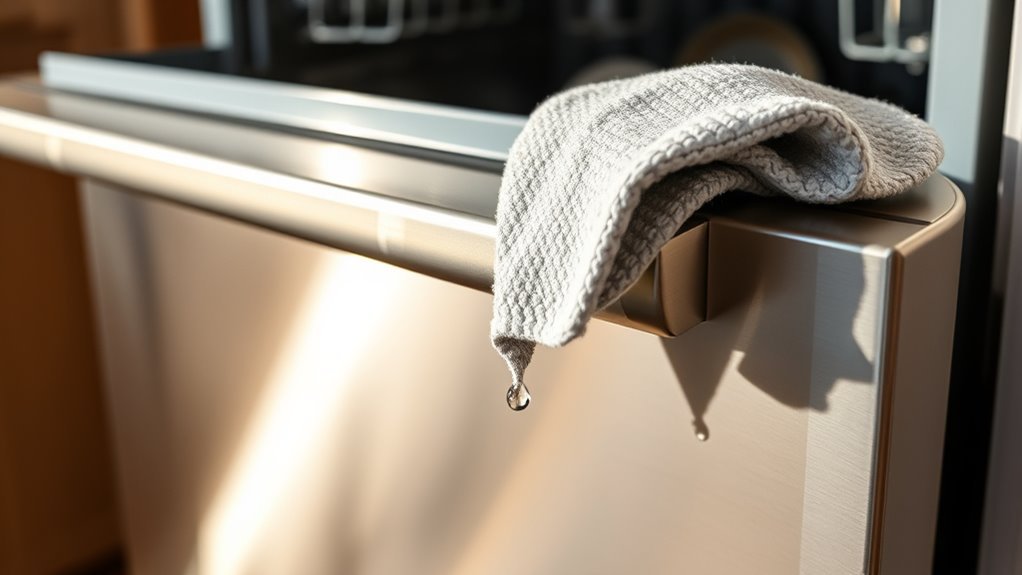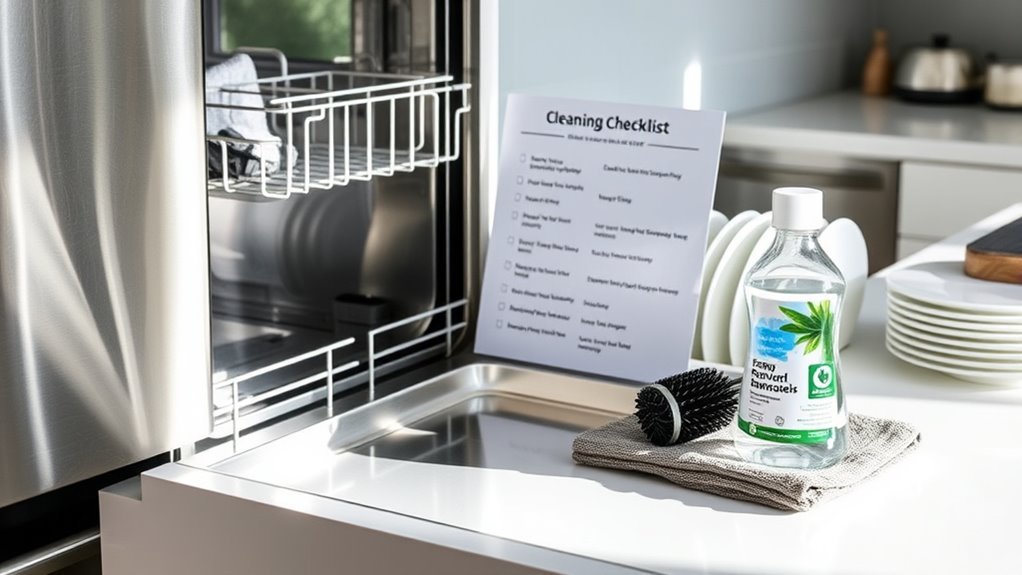Deep Cleaning Checklist for Dishwasher
To deep clean your dishwasher, start by removing and scrubbing the filters with warm, soapy water, then clear the spray arms of any clogged holes. Wipe down the door seals gently to prevent damage, and tackle odors by running a hot cycle with vinegar and baking soda. Don’t forget to clean the drain and garbage disposal area to avoid buildup. Following these steps will keep your dishwasher running smoothly and your dishes sparkling—explore ways to maintain and enhance its efficiency further.
Removing and Cleaning Dishwasher Filters

To keep your dishwasher running efficiently, start by removing and cleaning its filters. You’ll want to make filter maintenance a regular habit to prevent buildup that can slow performance. First, locate the filter at the bottom of your dishwasher and twist or lift it out carefully. Use warm, soapy water and a soft brush to gently scrub away trapped food particles and grease. Avoid harsh chemicals; simple cleaning techniques like soaking the filter in vinegar can help dissolve stubborn residue. Rinse thoroughly before placing it back into the unit. By staying on top of this simple step, you free yourself from costly repairs and guarantee your dishwasher works at peak power, giving you more time and freedom to focus on what truly matters.
Inspecting and Cleaning Spray Arms
Now that the filters are clean, check the spray arms for any stuck-on debris that could block water flow. Remove any gunk and use a toothpick or small brush to clear out clogged spray holes. This step guarantees your dishwasher sprays effectively and cleans your dishes thoroughly.
Removing Spray Arm Debris
One of the most important steps in deep cleaning your dishwasher is removing debris from the spray arms. This keeps water flowing freely, guaranteeing your dishes come out spotless. Regular spray arm maintenance prevents buildup and saves you from costly repairs. To start, detach the spray arms and rinse them under warm water, gently removing any visible debris. Avoid harsh tools that might damage the arms.
| Step | Tip for Freedom |
|---|---|
| Detach Spray Arms | Easily remove for thorough cleaning |
| Rinse Thoroughly | Use warm water to loosen debris |
| Check for Damage | Inspect for cracks or wear |
| Reinstall Securely | Guarantee spray arms spin freely |
Keep debris prevention in mind to enjoy a dishwasher that works smoothly and gives you more time for what matters.
Unclogging Spray Holes
Clogged spray holes can seriously affect your dishwasher’s cleaning power, so it’s essential to inspect and clear them regularly. Start by removing the spray arms and check each hole for buildup or debris. Use a toothpick or a thin wire to gently unclog any blocked holes, ensuring water flows freely during cycles. Rinse the spray arms under warm water to wash away loosened particles. Regular spray hole maintenance not only boosts cleaning efficiency but also prevents long-term damage. For clog prevention, consider running your dishwasher on a high-temperature cycle once a month and using a dishwasher cleaner to break down mineral deposits. Staying proactive with spray hole maintenance lets you regain control over your dishwasher’s performance and enjoy spotless dishes every time.
Wiping Down the Door and Seals

A thorough wipe down of the dishwasher door and seals is essential to prevent buildup and odors. You want to keep your dishwasher running smoothly without any sticky residues or grime causing trouble. Start by opening the door fully and using a damp cloth with mild soap to clean the inner and outer surfaces. Pay close attention to the rubber seals—they’re vital for door maintenance and seal care, ensuring water stays inside during cycles. Gently wipe around the edges and crevices, where dirt and moisture often hide. Avoid harsh chemicals that can damage seals or the door’s finish. Regularly caring for these parts not only extends your dishwasher’s life but also keeps your kitchen fresh and hassle-free. It’s a simple step toward freedom from dishwasher troubles.
Deodorizing and Removing Lingering Odors
Although your dishwasher may look clean, lingering odors can still affect its performance and your kitchen’s atmosphere. To invigorate things up, start by using odor neutralizers specifically designed for dishwashers. These help eliminate trapped smells without masking them. You can also add a few drops of essential oils like lemon or eucalyptus to a cotton ball and place it inside the dishwasher when it’s not in use. This natural approach not only deodorizes but leaves a subtle, revitalizing scent. Be certain to run an empty hot water cycle afterward to distribute the oils evenly. Regularly deodorizing your dishwasher guarantees it stays fresh, letting you enjoy a cleaner kitchen and dishes without unwanted odors interfering with your freedom to live and cook as you please.
Cleaning the Dishwasher Drain and Garbage Disposal

Since the dishwasher drain and garbage disposal work closely together, keeping both clean is vital for your appliance’s efficiency. Start by removing any debris trapped around the drain area to prevent clogs. Regular drain maintenance guarantees water flows freely and stops unpleasant odors from building up. Next, focus on disposal cleaning—run cold water while you switch on the disposal to flush out any stuck particles. You can also use a brush or a disposal cleaning tool to scrub away grime inside. By staying on top of drain maintenance and disposal cleaning, you avoid backups and keep your dishwasher running smoothly. This simple routine frees you from worrying about blockages and foul smells, giving you more time to enjoy the freedom of a clean, efficient kitchen.
Running a Deep Cleaning Cycle With Vinegar and Baking Soda
Before starting the deep cleaning cycle, make sure your dishwasher is empty and free of any food debris. You’ll pour a cup of vinegar into the bottom of the dishwasher to help break down grime and odors. After running a hot water cycle, sprinkle baking soda on the bottom and run a short cycle to freshen and brighten the interior.
Preparing the Dishwasher
When you’re ready to deep clean your dishwasher, you’ll want to start by removing any food debris and unloading all dishes. This clears the way for effective cleaning and prevents clogs. Next, check the dishwasher filter and rinse it under running water to remove trapped particles. Following dishwasher maintenance tips, inspect spray arms for blockages and clear any buildup. Before running the deep cleaning cycle with vinegar and baking soda, verify your cleaning solutions recommendations are suited for your dishwasher model to avoid damage. Leaving the dishwasher empty during this process lets the cleaning agents reach every corner, freeing you from lingering odors and grime. Preparing your dishwasher properly sets the stage for a thorough, liberating clean without hassle or restriction.
Vinegar Application Method
Although your dishwasher is empty, adding vinegar during a deep cleaning cycle helps break down grease, mineral deposits, and odors effectively. You’ll appreciate the vinegar benefits—it’s natural, affordable, and non-toxic, freeing you from harsh chemicals. Here’s how to use it:
- Pour one cup of white vinegar into a dishwasher-safe container on the top rack.
- Run the dishwasher on the hottest, longest cycle.
- Avoid using vinegar alternatives like lemon juice or citric acid here—they can be less effective or damage components.
- After the cycle, check for any lingering smells or residue; repeat if necessary for stubborn buildup.
This method restores your dishwasher’s efficiency, giving you more time to enjoy life without worrying about cleaning hassles.
Baking Soda Usage
Two simple ingredients—vinegar and baking soda—can work together to give your dishwasher a thorough deep clean. After running a vinegar cycle to break down grime, sprinkle a cup of baking soda across the bottom of your dishwasher. Baking soda benefits include deodorizing and gently scrubbing away leftover residue, leaving your machine fresh and spotless. Run a short, hot water cycle to let the baking soda work its magic. If you’re out of baking soda, baking soda alternatives like lemon juice mixed with salt can offer similar cleaning power, though not as mild or effective. Using these natural options gives you freedom from harsh chemicals while keeping your dishwasher in top shape. This simple routine keeps your appliance efficient and your dishes sparkling clean.
Frequently Asked Questions
How Often Should I Deep Clean My Dishwasher?
You should deep clean your dishwasher about once a month to keep it running smoothly. Following dishwasher maintenance tips, this cleaning frequency recommendation helps prevent buildup and odors, giving you more freedom to enjoy spotless dishes without hassle. If you use your dishwasher heavily, consider cleaning it more often. Staying on top of maintenance means less stress and more time doing what you love, instead of dealing with appliance issues.
Can I Use Bleach to Clean My Dishwasher?
When it comes to cleaning your dishwasher, you don’t want to bite off more than you can chew by using bleach—it can be too harsh and damage your appliance. Instead, look for bleach alternatives like white vinegar or baking soda, which offer safe cleaning without the risks. These options let you keep your dishwasher fresh while enjoying the freedom of worry-free maintenance. Stick to gentle methods to keep things running smoothly.
What Are Signs My Dishwasher Needs Deep Cleaning?
You’ll know your dishwasher needs deep cleaning when you notice clogged filters slowing down the wash cycle or unpleasant odors lingering inside. If your dishes aren’t coming out as clean as they used to, or you spot buildup around the spray arms and door seals, it’s time to act. Don’t let grime limit your freedom to enjoy hassle-free dishwashing—regular deep cleaning keeps your appliance running smoothly and smelling fresh.
Are There Dishwasher-Safe Cleaning Products to Avoid?
You’ll want to avoid dishwasher detergents with harsh chemicals or bleach, as they can damage your dishwasher’s components over time. Stay clear of abrasive cleaning tools like steel wool, which might scratch surfaces. Instead, choose gentle, dishwasher-safe cleaning products designed specifically for appliance care. This way, you get effective cleaning without risking your dishwasher’s lifespan, giving you the freedom to enjoy spotless dishes without worry.
How to Prevent Mold Growth Inside the Dishwasher?
You don’t want your dishwasher turning into a moldy jungle, right? For serious mold prevention, you’ve got to stay on top of dishwasher maintenance. After every cycle, leave the door ajar to let moisture escape—mold hates fresh air. Regularly clean the filters and wipe down seals to stop gunk buildup. Trust me, these simple habits keep your dishwasher fresh and free, giving you the freedom to enjoy spotless dishes without the gross surprises.






